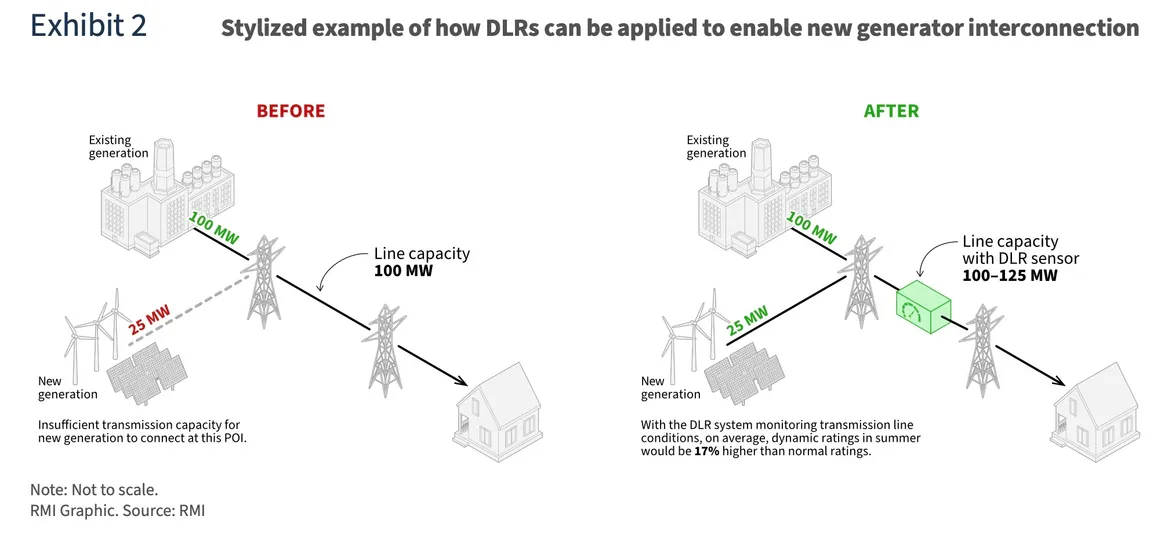How Dynamic Line Ratings Accelerate Renewable Energy Integration

Renewable Energy is a key to a Net Zero Future
With record-breaking temperatures and volatile weather becoming increasingly visible in daily life, integrating renewable energy and decarbonizing is an urgent necessity to combat climate change and achieve net zero goals. There is promising global momentum: countries, states, and cities are drafting net-zero pledges, and 2022 saw unprecedented growth in renewables globally, with 340 GW of renewables installed and $0.5 trillion invested.
While renewable energy is accelerating at a blistering pace, the growth is not fast enough. Renewable capacity needs to triple by 2030 to over 11,000 GW, and the $0.5 trillion invested in 2022 was less than a third of the necessary annual investment per year.
The renewable generation growth needed to achieve our climate goals is a larger challenge than simply financing and plugging in more solar panels and turbines. Studying, permitting, and implementing interconnection upgrades is an extensive process spanning years, placing many renewable energy projects in jeopardy of either perpetual delay or failure to realize their full generating potential.
The United States currently has an interconnection queue of over 2 terawatts of renewable energy awaiting connection to the grid. According to the Lawrence Berkeley National Laboratory, the queue has grown almost 5X in the past decade, with projects representing over $3 trillion in potential investment. Based on past completion rates, less than ¼ of these proposed projects (accounting for 14% of capacity) are likely to come online. In the UK, applications to connect to the grid have increased by 10x and resulted in wait times of up to 15 years.
Before developers can break ground on projects, grid operators have to complete studies on how each project will impact grid reliability, and if additional upgrades are needed to integrate them safely. The process could find that new or upgraded transmission lines are needed to integrate a large project, a task that can cost millions of dollars per mile.
To successfully integrate projects, clear critical renewable backlogs, and decarbonize, almost 48 million miles of lines must be built or replaced globally by 2040, and $600 billion per year invested in grids by 2030. To meet 2035 net zero plans, the US would need to build 75,000 miles of high-voltage transmission lines.
Transmission investment is another keystone of net zero. However, according to Canary Media, over the past 5 years, growth has slowed, “bogged down by conflicts over siting, permitting and paying for new transmission capacity.”
If transmission capacity lacks headroom to deliver the lowest-cost generation to consumers, then congestion occurs, causing more costly power to be used. In 2022, congestion costs to US consumers rose to $20.8 billion, compared to $7.5 billion the year before. In England and Wales, £808 million was spent in 2021 curtailing renewables due to insufficient transmission capacity.
Enhancing the grid with DLR
These challenges of integrating renewables and upgrading the grid are monumental - solving them involves a toolbox of infrastructure, policy, incentives, financing, and technology.
One important tool in the box is Dynamic Line Ratings (DLRs) which use sensors to determine when temperature and wind conditions can allow lines to carry more electricity, boosting line capacity by up to 40%. DLRs’ nimble nature is essential in unlocking near-term bottlenecks on existing transmission lines; DLR can be installed quickly at critical spots on the grid to alleviate bottlenecks of electrons. By increasing capacity on constricted areas, renewable energy can interconnect without the need for lengthy, expensive grid upgrades. Furthermore, DLR is complimentary to transmission rebuilds and reconductoring: capacity gains from DLR can aid in rerouting power during the planned outages needed to complete upgrades.

Modeling DLR across transmission systems
An analysis from the Rocky Mountain Institute studied the impacts of deploying Grid-Enhancing Technologies (GETS) across the PJM service territory. The results of deploying 95 GETs projects would result in integrating 6.6 gigawatts of new clean energy, and producing about $1 billion in cost savings.
The study found that DLR and 2 other GETs (Power Flow Control and Topology Optimization) each allow gigawatts of queued generation onto the grid at a fraction of the cost of rebuilding or reconductoring lines. When the technologies are combined in complementary scenarios, they can further increase the amount of generation connected to the grid.

Case Study: Unlocking Capacity with National Grid in the UK

LineVision is working with National Grid UK to expand transmission capacity to integrate offshore wind in England and Wales using DLR. An analysis of the project, released in October 2023, detailed early results from the project.
LineVision’s sensors were installed on a critical double circuit connecting offshore wind to the grid. Using conservative 24-hour DLR values, the project unlocked 9% additional capacity, with a boundary capacity uplift of 19%. Once fully integrated into the EMS with hourly DLR, the average capacity increase will be between 29-33%. Using 2021 data for reference, the 19% uplift in boundary capacity would result in £14.25 million in savings for the grid operator. Since the project's inception, 1 GW of additional capacity has been provided, allowing clean offshore wind to flow to consumers. The study also found a positive correlation between DLR values and offshore wind generation, suggesting that DLR can help the grid handle windy days when turbines are producing more power.
DLR’s role in a net zero future
Building a grid that can accommodate renewable energy and enable a net zero future is a stupendous task. Along with policy, infrastructure, finance, and other technology, Dynamic Line Ratings stand as a nimble and accessible tool that can integrate gigawatts of renewable energy while larger capital-intensive infrastructure catch up to demand.

